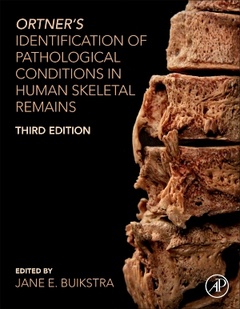Description
Ortner's Identification of Pathological Conditions in Human Skeletal Remains (3rd Ed.)
Coordinator: Buikstra Jane E.
Language: English
Subjects for Ortner's Identification of Pathological Conditions in...:
Keywords
3D visualization; ADNA; Actinomycosis; Alveolar lesions; Ancient DNA; Anemias; Antemortem tooth loss; Archeozoology; Bacteria; Birth defects; Bog bodies; Bone changes; Bone physiology; Bone remodeling; Breastfeeding and weaning; Brucellosis; CT scanning; Cancer; Caries; Cross-sectional geometry; Dental; Dental calculus; Dental chemistry; Dental development; Dental growth and development; Dentin; Dentition; Development; Diagnosis; Differential diagnosis; Disability theory; Disease; Diseases; Dislocation; Dwarfism; Enamel; Endochondral defects; Etiology; Excessive growth; Feminist theory; Fluorosis; Fracture; Glanders; Growth; Histomorphology; Histomorphometry; History; History of paleopathology; Human paleopathology; Human remains; Hyperostosis frontalis interna; Hypothalamus; Infection; Inflammation; Injury; Interpreting oral health; Intramembranous defects; Leprosy; Leukemia; Limbs; Lipid storage diseases; Lymphoma; Medicinal treatment; Metabolic diseases; Microbiome; Microdamage; Migration; Mineralization; Mobility; Modeling and remodeling; Modification; Molecular signaling; Mummification; Mummified tissue; Myeloma; Neoplasia; Neoplasm; Neoplasms; Nidus; Nocardiosis; Ortner; Osteitis; Osteobiography; Osteocyte lacunae; Osteological paradox; Osteomalacia; Osteomyelitis; Osteonecrosis; Osteoporosis; Osteosclerotic dysplasia; Overdispersion; Paleo-oncology; Paleodietary reconstruction; Paleoepidemiology; Paleopathology; Parasite; Parasites; Pathogen evolution; Pathophysiology; Periodontal disease
858 p. · 21.5x27.6 cm · Hardback
Description
/li>Contents
/li>Readership
/li>Biography
/li>Comment
/li>
Ortner's Identification of Pathological Conditions in Human Skeletal Remains, Third Edition, provides an integrated and comprehensive treatment of the pathological conditions that affect the human skeleton. As ancient skeletal remains can reveal a treasure trove of information to the modern orthopedist, pathologist, forensic anthropologist, and radiologist, this book presents a timely resource. Beautifully illustrated with over 1,100 photographs and drawings, it provides an essential text and material on bone pathology, thus helping improve the diagnostic ability of those interested in human dry bone pathology.
1. Introduction 2. History of Paleopathology 3. Theorectical Issues & Themes in Paleopathology 4. Normal Bone Structure and Development 5. Abnormal Bone Structure, Development, and Post-Depositoinal Changes 6. Bone Microstructure and Pathology 7. Imaging of Skeletal and Mummy Pathology 8. Ancient DNA 9. Trauma 10. Infectious Disease-Introduction, Biology, Osteomyelitis and Brucellosis 11. Infectious Diseases-Tuberculosis and Leprosy 12. Infectious Diseases-Treponematosis and Other Bacterial Infectious Diseases 13. Infectious Diseases-Fungal and Viral 14. Ecto and Endo Parasitic Diseases 15.Circulatory, Reticuloendothelial, and Hemopoietic Disorders 16. Metabolic Disorders 17. Endocrine Disturbances 18. Congenital and Neuromechanical Abnormalities of the Skeleton 19. Skeletal Dysplasias 20. Tumors 21. Non-specific Indicators of Pathology 22. Joint Disease 23. Dental Disease, Diet and Bone Chemistry 24. The Challenges and Opportunities of 21st Century Mummy Science 25. Animal Paleopathology
- Presents a comprehensive review of the skeletal diseases encountered in archaeological human remains
- Includes more than 1100 photographs and line drawings illustrating skeletal diseases, including both microscopic and gross features
- Based on extensive research on skeletal paleopathology in many countries
- Reviews important theoretical issues on how to interpret evidence of skeletal disease in archaeological human populations




